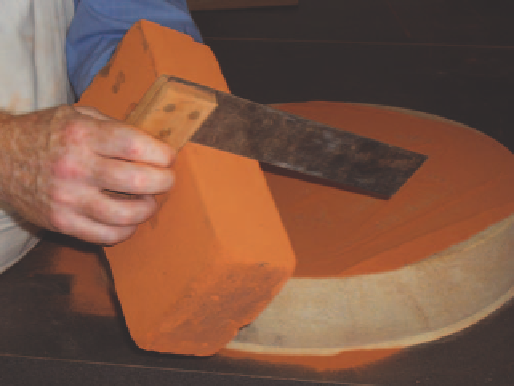Agriculture Reference
In-Depth Information
rubbed to ensure they are at 90º to each other is known in the craft as 'squaring'.
The square was also essential for transferring certain setting out lines for cutting,
or carving, certain ornamented faces, from one side of the brick to the other, pro-
viding the handle, or 'stock', always rested against a 'squared' face (Fig. 81).
Figure 81
Squaring the rubbing
brick with the try square
6. A Bevel, by which they cut the underfides of the Bricks, of Arches ftreight or
circular, to fuch oblique Angles as the Arches require, and alfo for other Ufes.
Also known as a 'sliding-bevel', Moxon wrongly describes it being used to '
…
cut the underfides of the Bricks, of Arches ftreight or circular…
'.
What he really meant was marking-out and checking rather than actually
cutting an arch voussoir; a process termed 'soffiting'. Some radiating voussoirs
meet the arch intrados obliquely so need their undersides, or soffit faces, cut
to the required angle. On a 'streight' (flat) arch, apart from the central 'key'
brick, all the voussoirs have different soffit bevels, as they become more inclined
away from the key to the skewback position. Of course there would also be a
need for bevels to be taken and transferred to the relevant voussoirs for the
extradosial line too.
The bevel would establish and transfer the relevant angles on the setting
out, or tracing, board to the bricks prior to cutting.
7. A fmall Trannel of Iron, or a large Nail ground'd to a fharp point, with which
they mark the Brick, either from a Square or Bevel, or a Mould made of thin
Wainfcot, or Paft-board to direct them in the cutting thereof.
A large 'rose-head', or flat 'clout' nail, ground to a sharp point is now termed
a 'scribe'. This is used to score or 'scribe' the outline of any templet to the
'squared' rubber, particularly the curved sections prior to rubbing or cutting it
to shape.

